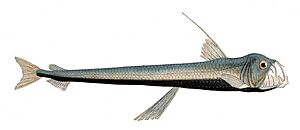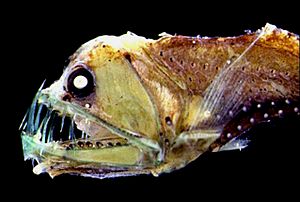Sloane's viperfish facts for kids
Quick facts for kids Sloane's viperfishTemporal range: Pleistocene to recent
|
|
|---|---|
 |
|
| Conservation status | |
| Scientific classification |
Sloane's viperfish, also known as Chauliodus sloani, is a fierce deep-sea fish found in oceans all over the world. It is a type of dragonfish. Two German scientists, Marcus Elieser Bloch and Johann Gottlob Schneider, first wrote about this fish in 1801. Female viperfish grow to be about 13 to 19 centimeters long before they can reproduce. Males are usually a bit smaller when they are ready to reproduce. This fish has two lines of special lights, called photophores, on its belly. These lights can glow! The viperfish might use them to hide from bigger fish swimming below, by matching the light coming from the surface.
Contents
What is a Sloane's Viperfish?
C. sloani belongs to a group of fish called Chauliodus, which includes all viperfishes. Viperfishes are deep-sea fish known for their glowing lights, very long teeth, and jaws that can open wide. There are nine other types of viperfishes, like C. danae and C. pammelas. What makes C. sloani special is that it lives in oceans all around the world.
Where Do They Live?
Sloane's viperfish live in warm and mild waters across the globe. You can find them in the Atlantic Ocean, the western Mediterranean Sea, and also in the Indian and Pacific Oceans. The water temperature affects how deep they can swim.
In the Atlantic, they are found between 35°N and 55°N latitude, with most of them living around 45°N. In the Arabian Sea, they mostly live south of 10°N.
Sometimes, other animals eat C. sloani. For example, in the central Mediterranean Sea, Atlantic bluefin tuna often eat them. Scientists have also found parts of C. sloani in the stomachs of whales, like the pygmy sperm whale and Gervais's beaked whale. These whales were found on the Canary Islands.
Amazing Anatomy
Super Jaws and Teeth
The most interesting part of C. sloani is its huge teeth. When the fish closes its mouth, the teeth fit together like a cage. This helps to trap any prey it catches. Its jaw can unhinge, meaning it can open its mouth up to 90 degrees! This allows it to catch prey that is up to 63% of its own body size.
However, its teeth are stuck in place; they don't move like some other fish teeth. Because its teeth are so big and fixed, it has to open its jaw very wide to catch food.
The teeth of C. sloani are always the same size, shape, and number in every fish. Each fang is very special. The viperfish probably uses its glowing light or a long fin ray that dangles in front of its mouth to attract prey. The first tooth, which is straight and sharp, might be used to hurt bigger prey. The second curved tooth is thought to act like a dagger, holding onto larger prey. All the teeth together form a cage to keep smaller prey from escaping.
Body Features
C. sloani has a tail fin that looks forked, a small fatty fin, and a fin on its back right behind its head. Most of its fins have soft rays. The fish's body is covered in a thick, clear, jelly-like layer. Like many deep-sea fish, its scales and tail bones are not very strong, and it does not have a gas-filled swim bladder to help it float.
What Do They Eat?
Sloane's viperfish mostly eat lanternfishes, other bony fish, and small crustaceans. An average viperfish probably eats at least one lanternfish every twelve days. Smaller viperfish have been found with proportionally larger prey in their stomachs compared to bigger ones.
They are not very picky eaters. They also eat other fish, eggs, and even algae. This is different from another viperfish, C. danae, which mainly eats crustaceans. However, smaller C. sloani have been found with crustaceans in their stomachs too.
C. sloani usually eats large prey. Sometimes, they can eat prey that is up to half their own body weight! Eating big meals means they don't have to eat often, which saves energy. This is why only viperfish under 12 centimeters long have been found with crustaceans in their stomachs. The fish is considered a specialist predator because it eats a small variety of prey. Some examples of what they eat include Cyclothone, Bregmaceros, Diaphus, Lampanyctus, and Myctophum. Studies show that their eating habits don't change with the seasons, and they eat at any time of day or night.
How They Glow
The special light-producing organs, called photophores, on the belly and sides of the viperfish allow it to glow. This is called bioluminescence. Recent studies have shown that certain hormones, adrenaline and noradrenaline, help the viperfish produce light. Adrenaline levels are higher in the photophores. Scientists also observed that when the viperfish's tail was gently squeezed, it would glow for about 5 to 10 seconds.



